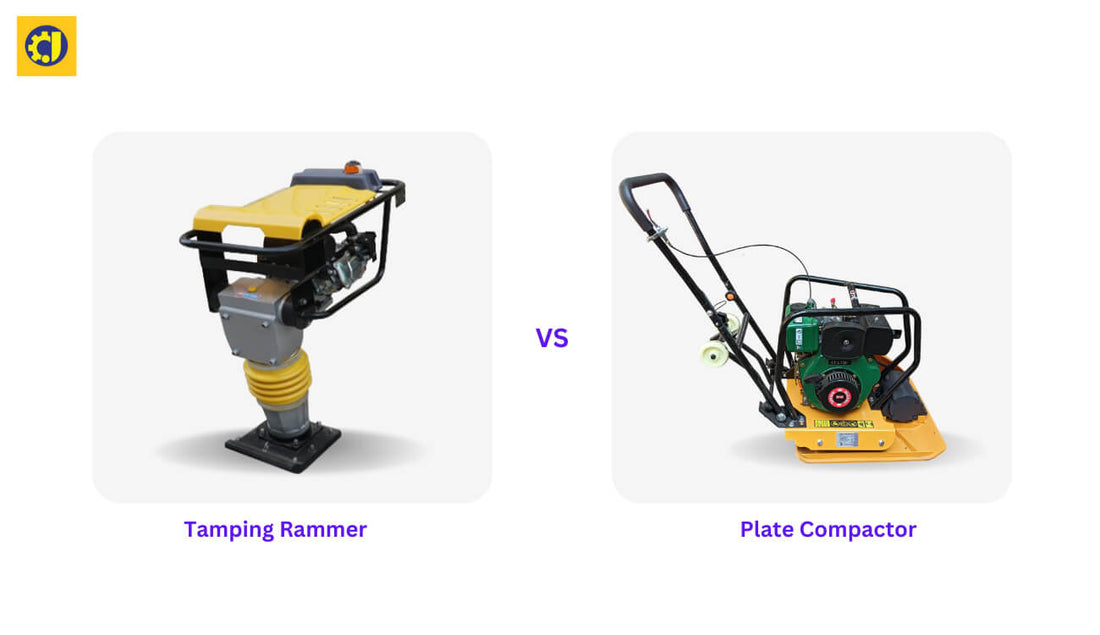
Tamping Rammer vs Plate Compactor: Which Is Right for Your Project?
When
it comes to compacting soil, whether you're working on a landscaping project or preparing a foundation, using the right equipment is critical. Two of the most commonly used tools in construction and landscaping for soil compaction are the tamping rammer and the plate compactor. While both machines serve the same primary purpose—compacting soil or other materials—they function differently and are ideal for different types of jobs.
In this article, we’ll break down the differences between a tamping rammer and a plate compactor, explore their specific use cases, and help you decide which one is right for your projects.
Before that let's see why soil cpompaction is needed before any constructio
Soil compaction is crucial before construction to ensure a strong, stable, and durable foundation. Here’s why it’s necessary:
1. Increases Soil Strength: Compaction improves the load-bearing capacity of the soil, allowing it to support buildings and structures without shifting or settling.
2. Reduces Settlement: Properly compacted soil minimizes future settling, which can cause cracks in walls, foundations, and pavement.
3. Prevents Water Seepage: Compacted soil has fewer air gaps, reducing water infiltration and preventing erosion or structural weakening.
4. Improves Stability: It stabilizes the construction area, making it safer and more reliable for heavy equipment and building loads.
5. Enhances Durability: Compacted soil resists wear and environmental factors better, increasing the lifespan of the structure above.
In short, compaction ensures the ground is solid, safe, and ready to support construction without costly issues later.
---
What is a Tamping Rammer?

A tamping rammer, often simply called a "rammer," is a machine designed to compact soil by delivering a series of powerful, high-impact blows. It typically features a smaller foot and operates with a percussive motion—essentially stamping the ground rapidly with great force.
Rammers are powered by gasoline, diesel, or electric motors and use a piston system to create the compaction force. Their vertical, jumping motion makes them highly effective at compacting cohesive soils like clay and silt, which tend to retain moisture and require more concentrated force to settle properly.
---
The Need for a Tamping Rammer
You should consider using a tamping rammer when working in the following conditions:
Confined spaces:
Its compact size makes it perfect for tight areas like trenches and corners.
Cohesive soil types:
Ideal for clay, silt, or other sticky soils that are hard to compact with vibration alone.
Deep compaction:
Its high-impact force allows it to compact deeper layers of soil more effectively than broader machines.
Because of its strength and ability to work in tight spaces, the tamping rammer is a favorite among contractors who need to ensure a solid, stable foundation in small or awkward areas.
---
What is a Plate Compactor?

A plate compactor, also known as a vibrating plate or forward plate compactor, uses a heavy, flat plate that vibrates to compact materials. Instead of vertical tamping like a rammer, it uses rapid forward motion combined with vibrations to settle and compress soil, gravel, sand, or asphalt.
Plate compactors come in various sizes and types—forward, reversible, and heavy-duty—and are best suited for larger, more open areas.
---
The Need for a Plate Compactor
Plate compactors are the go-to equipment for:
Granular soils:
These include sand, gravel, and other non-cohesive materials that respond well to vibration.
Larger areas:
Ideal for driveways, patios, roads, and sidewalks where more surface area needs to be covered.
Asphalt work:
Frequently used for compacting asphalt during paving jobs.
Their efficient design and broad coverage make them excellent for achieving even compaction across wide surfaces.
---
Tamping Rammer vs Plate Compactor: Key Differences
| Feature | Tamping Rammer | Plate Compactor |
| Motion | Verticle, Percussive (jumping) | Horizontal, Vibrating |
| Best for Soil Type | Cohesive (clay, silt) | Granular(sand, gravel) |
| Ideal Use | Trenches, tight spots, deep compaction | Large flat areas, shallow compaction |
| Compaction Depth | Deeper penetration | More surface-level compaction |
| Size and Maneuver ability | Compact and agile | Larger, requires more room |
| Operation | More physical effort to control | Easier to maneuver on open ground |
---
Which One Is Better?
There’s no clear winner between the tamping rammer and the plate compactor—they’re both great at what they’re designed to do. The better choice comes down to your specific project needs:
Choose a tamping rammer if you’re working with clay or silt, need deep compaction, or are dealing with tight spaces like trenches.
Choose a plate compactor if you’re covering a large, flat area with sand, gravel, or asphalt, and need fast, even compaction.
---
Which One Should You Choose?
Before renting or purchasing a machine, consider the following questions:
1.What type of soil are you compacting?
Clay and silt = Tamping Rammer
Sand and gravel = Plate Compactor
2. How big is the area you need to compact?
Small or narrow space = Tamping Rammer
Wide, open area = Plate Compactor
3. How deep do you need to compact?
Deeper layers = Tamping Rammer
Surface level = Plate Compactor
4. Is maneuverability important?
Rammers work better in tight spots.
Plate compactors excel in open, flat areas.
---
Final Thoughts
Both tamping rammers and plate compactors are essential tools in construction and landscaping. Understanding the difference between the two helps you make a smart investment or rental decision. By choosing the right compaction equipment, you’ll not only improve the stability of your project but also save time, labor, and costs in the long run.
If you're planning a project that involves soil compaction, assess your needs carefully—and if in doubt, consult with an equipment rental expert or construction professional.